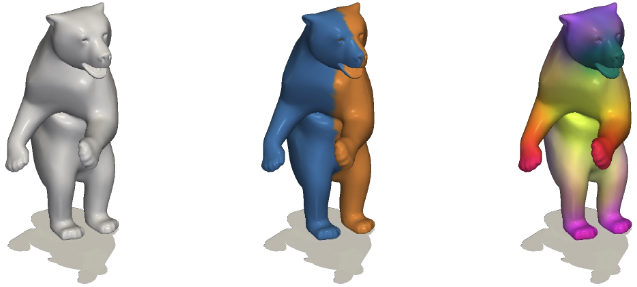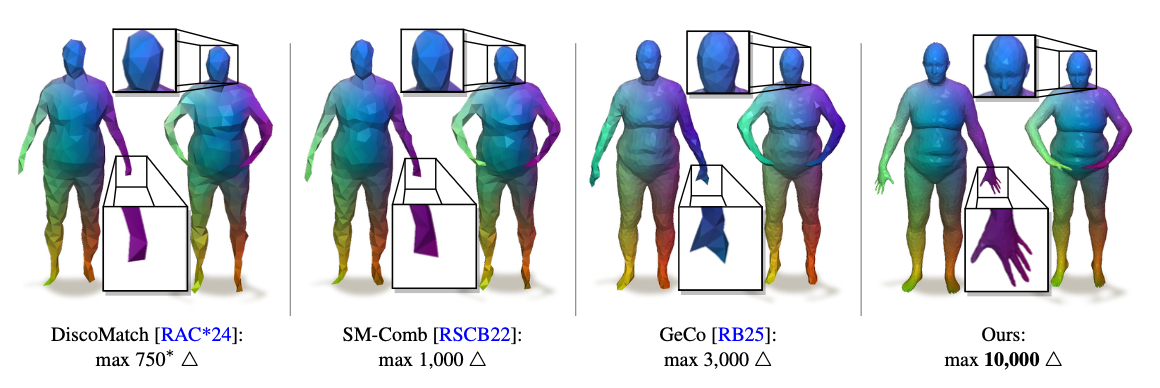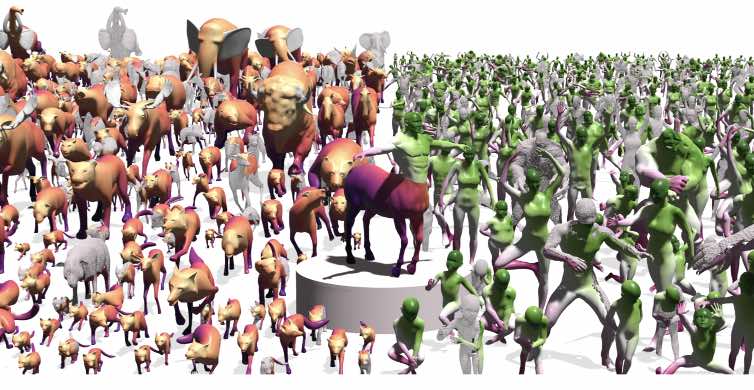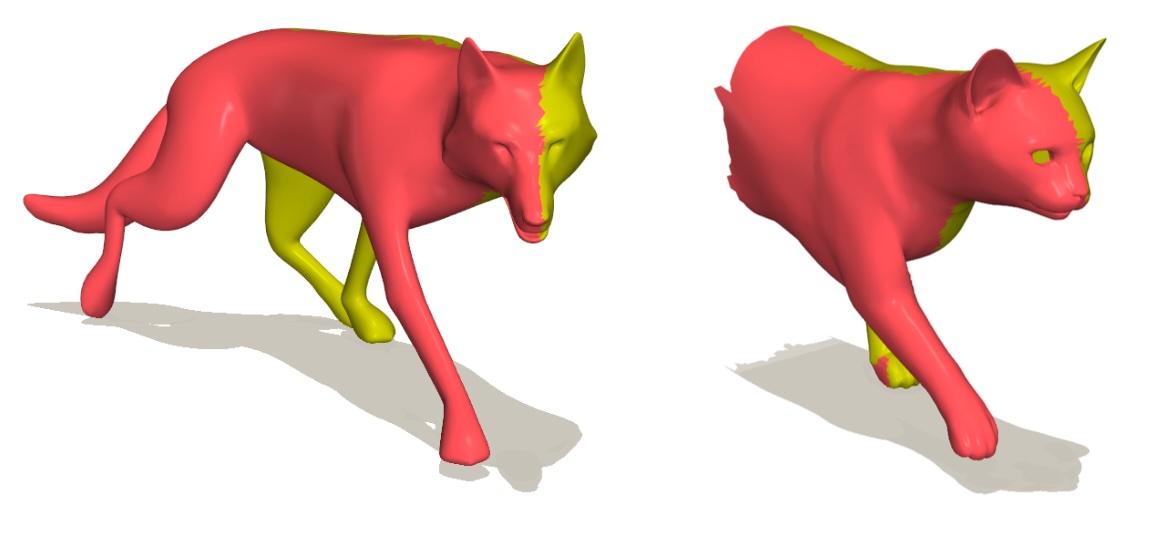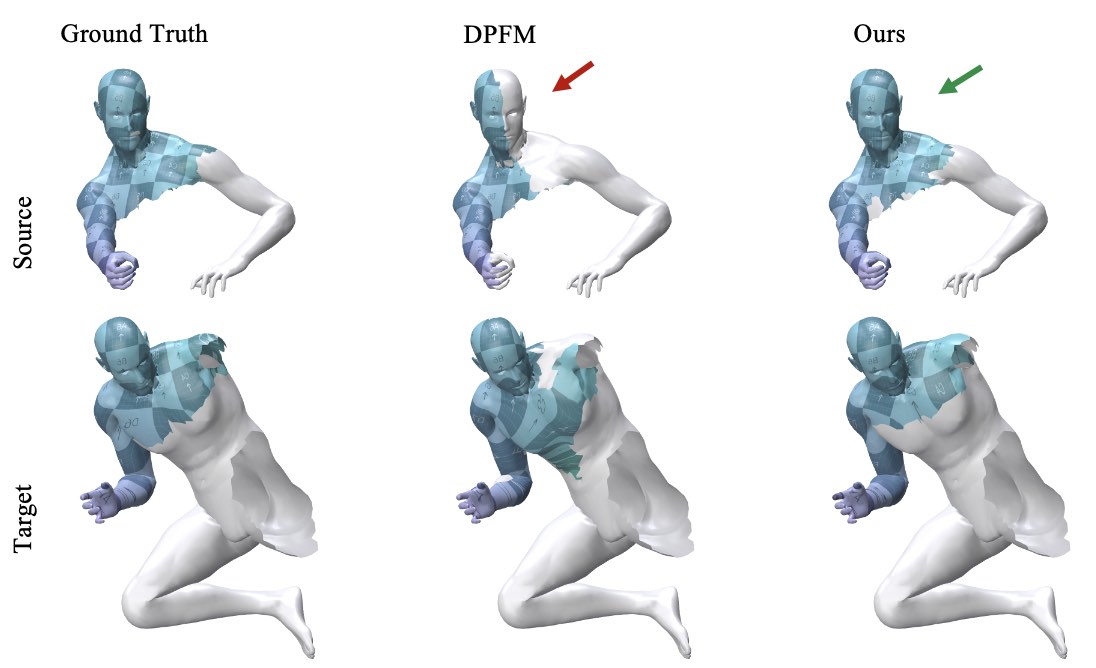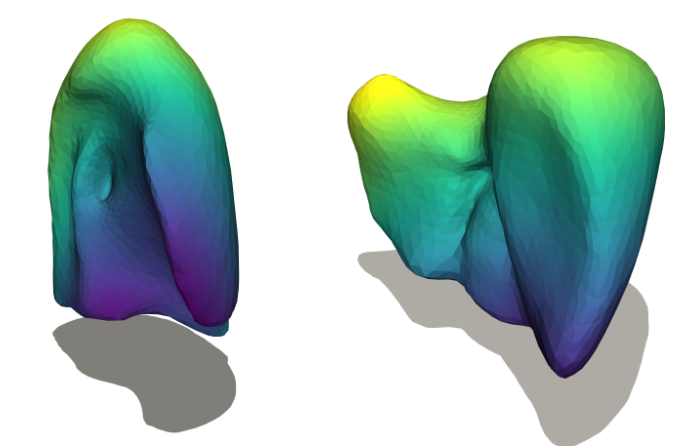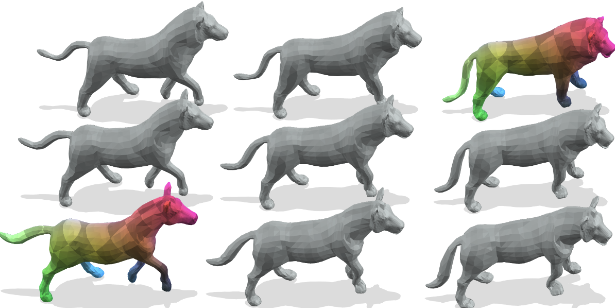My publications
You can also find my articles on my Google Scholar.
2026
- Symmetry Informative and Agnostic Feature Disentanglement for 3D ShapesIn International Conference on 3D Vision (3DV) , Mar 2026
Shape descriptors, i.e. per-vertex features of 3D meshes or point clouds, are fundamental to shape analysis. Over the past decades, various handcrafted geometry-aware descriptors and feature refinement techniques have been proposed. Recently, several studies have initiated a new research direction by leveraging features from image foundation models to create semantics-aware descriptors, demonstrating advantages across tasks like shape matching, editing, and segmentation. Symmetry, another key concept in shape analysis, has also attracted increasing attention. Consequently, constructing symmetry-aware shape descriptors is a natural progression. Although a recent method successfully extracted symmetry-informative feature from semantic-aware descriptors, its features are only one-dimensional, neglecting other valuable semantic information. Besides, the extracted symmetry-informative feature is usually noisy and yields tiny miss-classified patches. To address these gaps, we propose a feature disentanglement approach which at the same time is symmetry informative and symmetry agnostic. Further, we propose a feature refinement technique to improve robustness of predicted symmetry informative features. Extensive experiments, including intrinsic symmetry detection, left/right classification, and shape matching, demonstrate the effectiveness of our proposed framework compared to various state-of-the-art methods, both qualitatively and quantitatively.
@inproceedings{weissberg2026symm, author = {Weißberg, Tobias and Wang, Weikang and Roetzer, Paul and El Amrani, Nafie and Bernard, Florian}, title = {{Symmetry Informative and Agnostic Feature Disentanglement for 3D Shapes}}, booktitle = {International Conference on 3D Vision (3DV)}, month = mar, year = {2026} }
2025
- High-Resolution 3D Shape Matching with Global Optimality and Geometric ConsistencyNafie El Amrani†, Paul Roetzer†, and Florian BernardComputer Graphics Forum, Jun 2025
3D shape matching plays a fundamental role in applications such as texture transfer and 3D animation. A key requirement for many scenarios is that matchings exhibit geometric consistency, which ensures that matchings preserve neighbourhood relations across shapes. Despite the importance of geometric consistency, few existing methods explicitly address it, and those that do are either local optimisation methods requiring accurate initialisation, or are severely limited in terms of shape resolution, handling shapes with only up to 3,000 triangles. In this work, we present a scalable approach for geometrically consistent 3D shape matching that, for the first time, scales to high-resolution meshes with up to 10,000 triangles. Our method follows a two-stage procedure: (i) we compute a globally optimal and geometrically consistent mapping of surface patches on the source shape to the target shape via a novel integer linear programming formulation. (ii) we find geometrically consistent matchings of corresponding surface patches which respect correspondences of boundaries of patches obtained from stage (i). With this, we obtain dense, smooth, and guaranteed geometrically consistent correspondences between high-resolution shapes. Empirical evaluations demonstrate that our method is scalable and produces high-quality, geometrically consistent correspondences across a wide range of challenging shapes. We will make our code public upon acceptance.
@article{elamrani2025highres, doi = {10.1111/cgf.70208}, journal = {Computer Graphics Forum}, title = {{High-Resolution 3D Shape Matching with Global Optimality and Geometric Consistency}}, author = {El Amrani, Nafie and Roetzer, Paul and Bernard, Florian}, month = jun, year = {2025} } - Beyond Complete Shapes: A Benchmark for Quantitative Evaluation of 3D Shape Matching AlgorithmsComputer Graphics Forum, Jun 2025
Finding correspondences between 3D shapes is an important and long-standing problem in computer vision, graphics and beyond. While approaches based on machine learning dominate modern 3D shape matching, almost all existing (learning-based) methods require that at least one of the involved shapes is complete. In contrast, the most challenging and arguably most practically relevant setting of matching partially observed shapes, is currently underexplored. One important factor is that existing datasets contain only a small number of shapes (typically below 100), which are unable to serve data-hungry machine learning approaches, particularly in the unsupervised regime. In addition, the type of partiality present in existing datasets is often artificial and far from realistic. To address these limitations and to encourage research on these relevant settings, we provide a generic and flexible framework for the procedural generation of challenging partial shape matching scenarios. Our framework allows for a virtually infinite generation of partial shape matching instances from a finite set of shapes with complete geometry. Further, we manually create cross-dataset correspondences †: These authors contributed equally to this work. between seven existing (complete geometry) shape matching datasets, leading to a total of 2543 shapes. Based on this, we propose several challenging partial benchmark settings, for which we evaluate respective state-of-the-art methods as baselines.
@article{ehm2025becos, doi = {10.1111/cgf.70186}, journal = {Computer Graphics Forum}, title = {{Beyond Complete Shapes: A Benchmark for Quantitative Evaluation of 3D Shape Matching Algorithms}}, author = {Ehm, Viktoria and El Amrani, Nafie and Xie, Yizheng and Bastian, Lennart and Gao, Maolin and Wang, Weikang and Sang, Lu and Cao, Dongliang and Weißberg, Tobias and L{\"a}hner, Zorah and Cremers, Daniel and Bernard, Florian}, month = jun, year = {2025}, } - Symmetry Understanding of 3D Shapes via Chirality DisentanglementWeikang Wang†, Tobias Weißberg†, Nafie El Amrani , and 1 more authorIn IEEE/CVF International Conference on Computer Vision (ICCV) , Jun 2025
Chirality information (i.e., information that allows distinguishing left from right) is ubiquitous for various data modes in computer vision, including images, videos, point clouds, and meshes. Contrary to symmetry, for which there has been a lot of research in the image domain, chirality information in shape analysis (point clouds and meshes) has remained underdeveloped. Although many shape vertex descriptors have shown appealing properties (e.g. robust to rigid-body pose transformations), they are not able to disambiguate between left and right symmetric parts. Considering the ubiquity of chirality information in different shape analysis problems and the lack of chirality-aware features within current shape descriptors, developing a chirality feature extractor becomes necessary and urgent. In this paper, based on the recent framework Diff3f, we proposed an unsupervised chirality feature extraction pipeline to decorate shape vertices with chirality-aware information, extracted from 2D foundation models. Quantitative and qualitative results of various experiments and downstream tasks include left-right disentanglement, shape matching, and part segmentation conducted on a variety of datasets proving the effectiveness and usefulness of our extracted chirality features.
@inproceedings{wang2025chirality, author = {Wang, Weikang and Weißberg, Tobias and El Amrani, Nafie and Bernard, Florian}, title = {Symmetry Understanding of 3D Shapes via Chirality Disentanglement}, booktitle = {IEEE/CVF International Conference on Computer Vision (ICCV)}, month = jun, year = {2025}, } - EchoMatch: Partial-to-Partial Shape Matching via Correspondence ReflectionIn Proceedings of the IEEE/CVF Conference on Computer Vision and Pattern Recognition (CVPR) , Jun 2025
Finding correspondences between 3D shapes is a crucial problem in computer vision and graphics. While most research has focused on finding correspondences in settings where at least one of the shapes is complete, the realm of partial-to-partial shape matching remains under-explored. Yet, it is important since in many applications shapes are only observed partially due to occlusion or scanning. Finding correspondences between partial shapes comes with an additional challenge: We not only want to identify correspondences between points on either shape but also have to determine which points of each shape actually have a partner. To tackle this challenging problem, we present EchoMatch, a novel framework for partial-to-partial shape matching that incorporates the concept of correspondence reflection to enable an overlap prediction within a functional map framework. With this approach, we show that we can outperform current SOTA methods in challenging partial-to-partial shape matching problems.
@inproceedings{xie2025echomatch, author = {Xie, Yizheng and Ehm, Viktoria and Roetzer, Paul and Amrani, Nafie El and Gao, Maolin and Bernard, Florian and Cremers, Daniel}, title = {EchoMatch: Partial-to-Partial Shape Matching via Correspondence Reflection}, booktitle = {Proceedings of the IEEE/CVF Conference on Computer Vision and Pattern Recognition (CVPR)}, month = jun, year = {2025} }
2024
- A Universal and Flexible Framework for Unsupervised Statistical Shape Model LearningNafie El Amrani, Dongliang Cao, and Florian BernardIn Medical Image Computing and Computer Assisted Intervention (MICCAI) , Oct 2024
We introduce a novel unsupervised deep learning framework for constructing statistical shape models (SSMs). Although unsupervised learning-based 3D shape matching methods have made a major leap forward in recent years, the correspondence quality of existing methods does not meet the demanding requirements necessary for the construction of SSMs of complex anatomical structures. We address this shortcoming by proposing a novel deformation coherency loss to effectively enforce smooth and high-quality correspondences during neural network training. We demonstrate that our framework outperforms existing methods in creating high-quality SSMs by conducting extensive experiments on five challenging datasets with varying anatomical complexities. Our proposed method sets the new state of the art in unsupervised SSM learning, offering a universal solution that is both flexible and reliable. Our source code is publicly available at https://github.com/NafieAmrani/FUSS.
@inproceedings{elamrani2024fuss, author = {El Amrani, Nafie and Cao, Dongliang and Bernard, Florian}, title = {A Universal and Flexible Framework for Unsupervised Statistical Shape Model Learning}, booktitle = {Medical Image Computing and Computer Assisted Intervention (MICCAI)}, month = oct, year = {2024} } - Spectral Meets Spatial: Harmonising 3D Shape Matching and InterpolationIn Proceedings of the IEEE/CVF Conference on Computer Vision and Pattern Recognition (CVPR) , Jun 2024
Although 3D shape matching and interpolation are highly interrelated, they are often studied separately and applied sequentially to relate different 3D shapes, thus resulting in sub-optimal performance. In this work we present a unified framework to predict both point-wise correspondences and shape interpolation between 3D shapes. To this end, we combine the deep functional map framework with classical surface deformation models to map shapes in both spectral and spatial domains. On the one hand, by incorporating spatial maps, our method obtains more accurate and smooth point-wise correspondences compared to previous functional map methods for shape matching. On the other hand, by introducing spectral maps, our method gets rid of commonly used but computationally expensive geodesic distance constraints that are only valid for near-isometric shape deformations. Furthermore, we propose a novel test-time adaptation scheme to capture both pose-dominant and shape-dominant deformations. Using different challenging datasets, we demonstrate that our method outperforms previous state-of-the-art methods for both shape matching and interpolation, even compared to supervised approaches.
@inproceedings{cao2024spectral, author = {Cao, Dongliang and Eisenberger, Marvin and El Amrani, Nafie and Cremers, Daniel and Bernard, Florian}, title = {Spectral Meets Spatial: Harmonising 3D Shape Matching and Interpolation}, booktitle = {Proceedings of the IEEE/CVF Conference on Computer Vision and Pattern Recognition (CVPR)}, month = jun, year = {2024} }
